#enemies to friends to not lovers to enemies to one killing the other. peak literature
Explore tagged Tumblr posts
Text
just finished the poppy war trilogy what the FUCK WAS THATTTT
#i mean this in the positive way#head in my hands#im gonna strangle rin with my bare hands#me: i love stories where the character becomes the worst version of themselves through the cycle of revenge and vengeance#me when that actually happens: I CANT BELIEVE THEIR ACTIONS CAUGHT UP TO THEM AND TRAGEDY BEFELLED THEIR ENTIRE LIFE!!!!!#ok but actually#how she kinda broke the cycle by choosing to die and not keep going#because how all the others had continued their reign and their wrath and ruined the country more#AND THEN IT CIRCLJNG BACK TOO#cause the whole thing in the first book of ‘why would the red emperor kill his wife if he loved her’#AND THE NEZHA KILLING HER ON SPEER AS THE HESPARIAMS GET CLOSER AND THE PAIN BECAUSE OF HOW#MUCH HE LOVES HER#love was there and it didn’t change anything. but my god. the love was there#don’t get me started on kitay. i don’t even want to think about kitay.#HEAD IN MY HANNDSSSSS#i think everyone should read this book. btw.#enemies to friends to not lovers to enemies to one killing the other. peak literature#me rambling#the poppy war#the burning god#they weren’t kidding that god really can burn
71 notes
·
View notes
Text
Part of my Ikemen Villains experience has been creating Robin OCs (MCs?) that are partially inspired by 19th century classical literature/poetry, save for about one or two, one for each boy.
This will be my masterlist for the main 9 as of July 2024. Of course, dynamics and backstories are subject to change.
William:

(Note: She is the one who will most likely be written in 2nd person POV. ) Dynamic: corrupter and corrupted, fast burn, partners in crime
Harrison:

Dynamic: Normal x Normal (healthy dynamic in spite of their traumas, definitely the healthiest of the pool because it's going to get odd from here), mutual pining, slow burn
Liam:

Dynamic: friends to lovers, deep emotional scars, heartbreak, second love, angst, hurt/comfort, slow burn, famous x normal
Elbert:

Dynamic: wallflower x obsessive personality, yandere, gothic horror (think Crimson Peak but without the-you-know-what, and I know Crimson Peak is set in the Edwardian era shhh)
Roger:
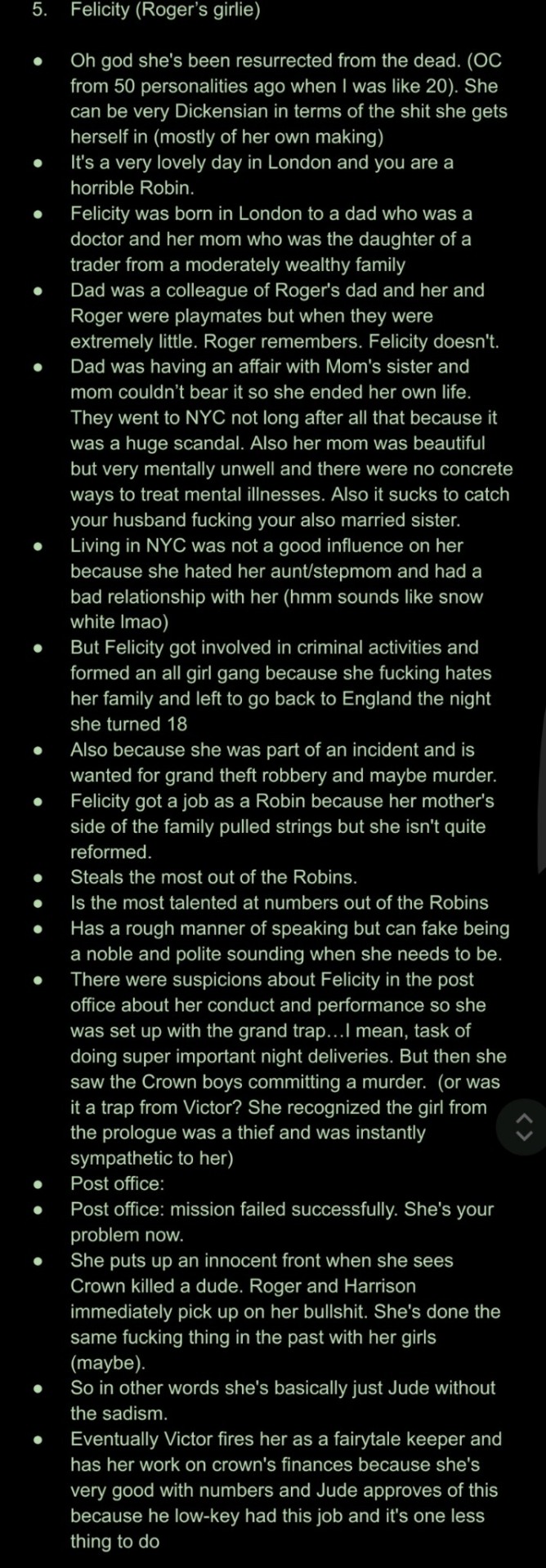
Dynamic: tough girl x bruiser, belligerent sexual tension, slap slap kiss, I think they will kill each other first and that's beautiful
Alfons
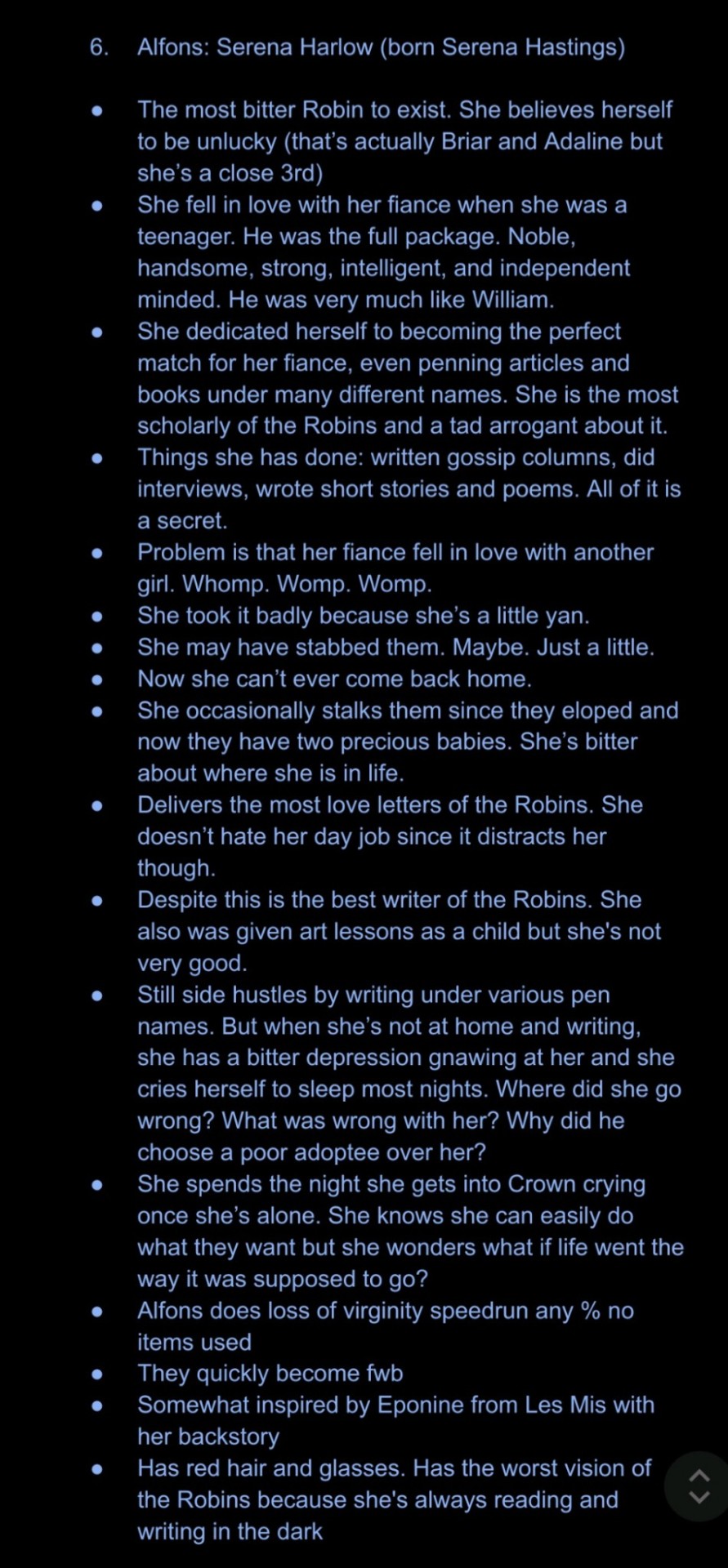
Dynamic: FWB, yandere (mc), heartbreak, second love, enemies to FWB to enemies to lovers, partners in crime, banter (note: I have two more bullet points in the doc, but they are purposely concealed for now *shifts eyes*)
Ellis:
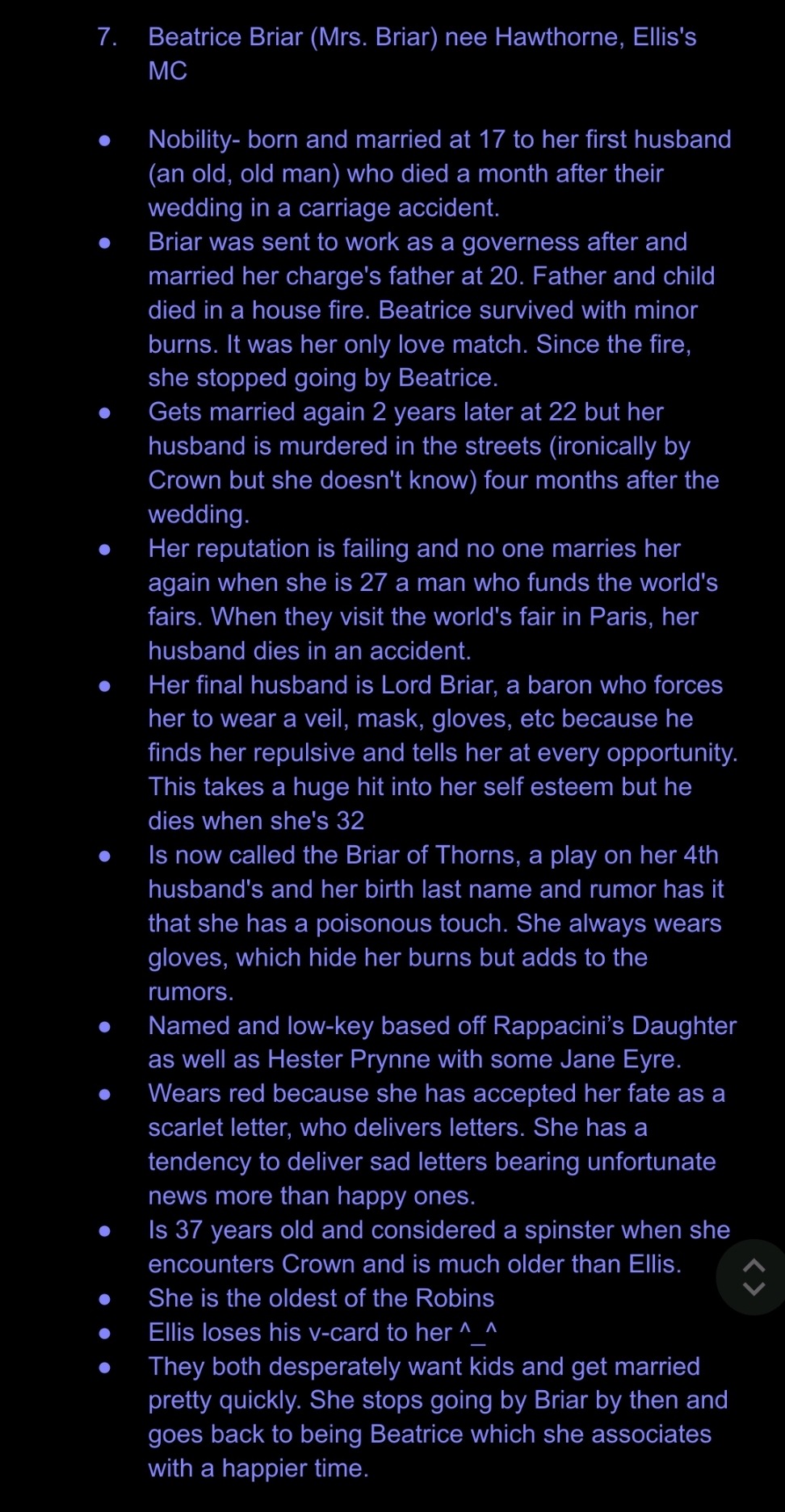
Dynamic: 🔥age gap🔥 (older woman x younger man), yandere, everyone can see it, second chance love (6th time, actually)
Jude:
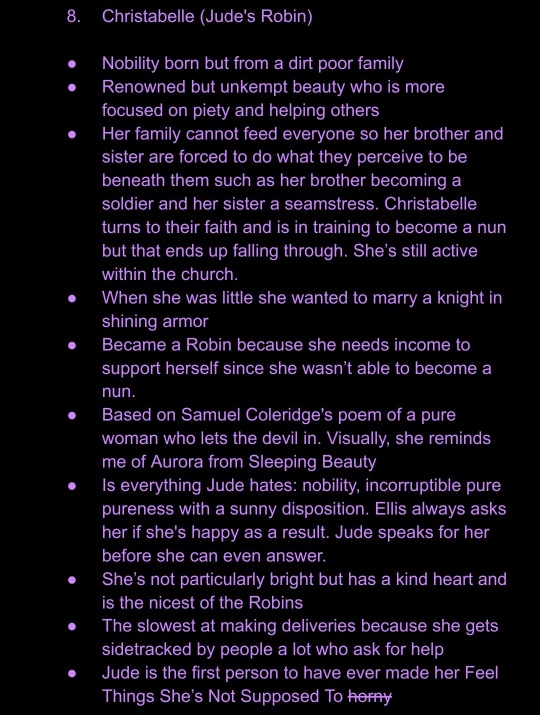
Dynamic: grumpy vs sunshine, rich vs poor, class difference, opposites attract, oblivious to love, bad boy and good girl/all girls want bad boys (also obviously bsdm dynamics)
Victor:
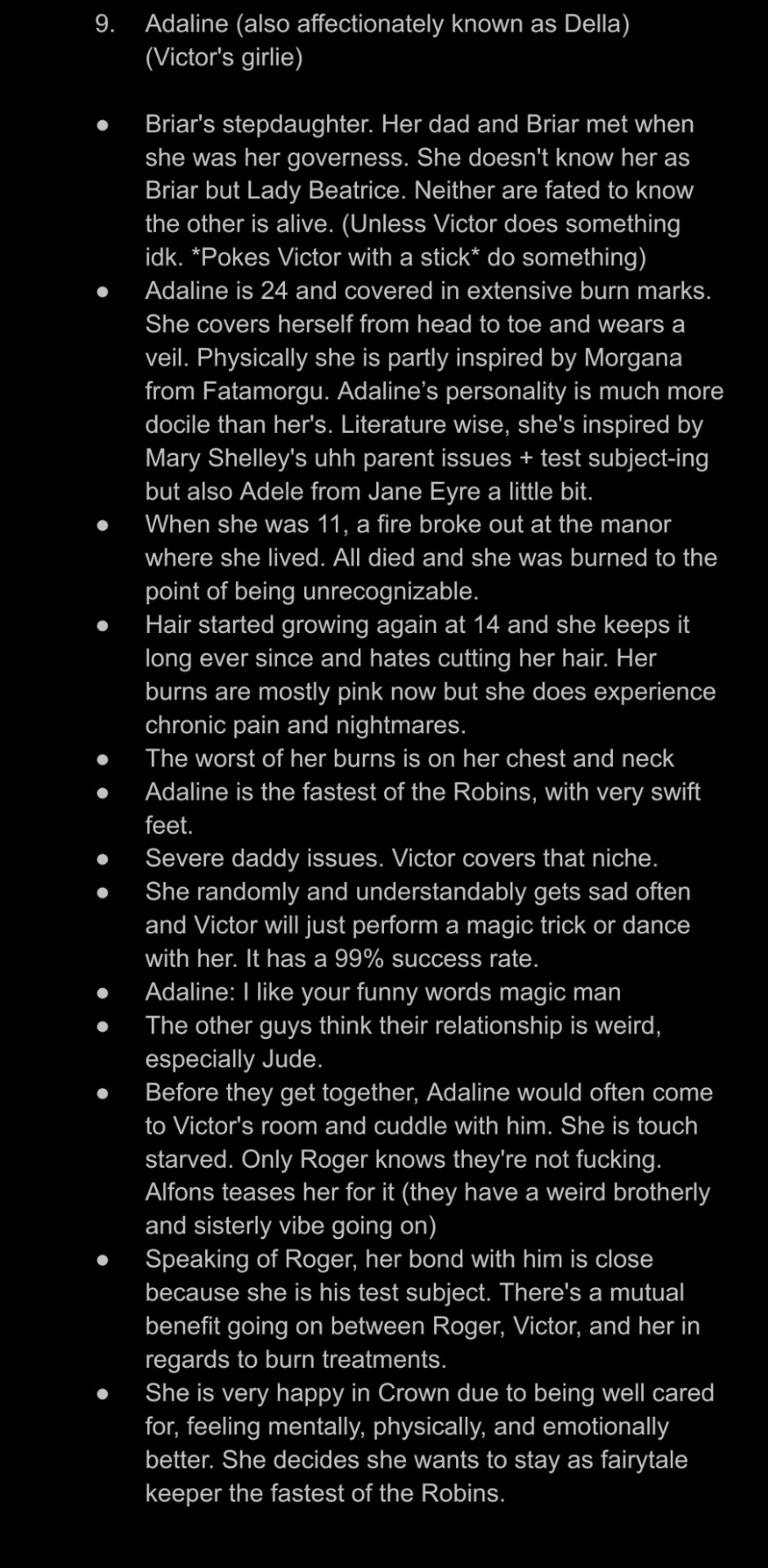
Dynamic: age gap (older man, younger woman), mutual pining (kinda), daddy issues, slow burn, hurt/comfort, angst
#ikemen villains#ikevil#ikevil mc#ikevil oc#jude jazza#ellis twilight#alfons sylvatica#roger barel#liam evans#ikevil victor#william rex#harrison gray#elbert greetia#ikevil roger#ikevil ellis#ikevil jude#ikevil william#ikevil alfons#ikevil liam#ikevil harrison#ikevil elbert#I've had them in concept for about 2 months now some have been better developed than others like Serena and Briar/Beatrice and Della#Christabelle to a lesser extent tbh but I do have writings of her#I've actually been super nervous about putting them on tumblr but they are my pookies and I love them all#I'm going to revamp my pinned post because this is super important to me#I have currently 2 more Robins for the Germans but they are currently in hiding for now#one of those 2 is hinted here already
38 notes
·
View notes
Note
You've probably said this before but what's your favorite aspect of the TOG series? I've only read like ten pages of the first book lol
aaaaa thank u for asking!! this sort of leads into something i’ve been meaning to talk about for a while so i hope you’re prepared for An Essay No One Wanted By Me. anyway this is a two-part answer, read below:
1. Aelin. Celaena. The main bitch, whatever you wanna call her lol. Without her I probably wouldn’t have cared about the series at all and wouldn’t currently be trapped in ToG tumblr hell reluctantly stanning a racist and homophobic series, but unfortunately when I was like twelve years old or whatever and read the first book I literally imprinted on Celaena like a baby duckling. To the extent that she became, like, the default avatar for all my maladaptive daydreaming and If I Don’t Project On Her At All Times I Will Die. It’s not like she’s the only thing I like about the series (I loooove a lot of the other characters, especially the gals, and the writing can be really great and engaging and cinematic) but Aelin has always been the supermassive black hole at the center of it all for me. I wouldn’t know how to even begin untangling her character from my psyche at this point. It’s honestly a little disturbing. Anyway.
2. Part two is a quality of the series that I feel was unprecedented in its strength in the first five books of the series (ToG-QoS plus the prequel novellas) and really really disappointingly weak in the last two books (EoS-KoA). Like I said above, Aelin has always been my main interest in tog so I read and enjoyed the last two anyway, but I definitely felt the loss of this - “this” being the detail and attention paid to all different types of relationships between characters, and how rich and unpredictable those relationships were as a result.
That sounds like kind of a broad, vague thing, but what I mean is that (in my opinion) rarely are romances and friendships and rivalries explored with such nuance, complexity, drama, and realism in most YA as they are in ToG. I remember reading Cassandra Clare’s books (lmao.) as a pre teen and loving those as well, but totally being able to predict who was going to end up with who, and finding the character dynamics to be pretty cut and dry.
In ToG that’s not the case at all. Like, you’ve got Celaena and Sam, a really complex example of enemies to lovers to….. Tragically Dead Boyfriend Whose Demise Fuels My Guilt and Self-Hatred For Seven More Books, Lysandra and Aelin, two girls pitted against each other by their abuser who team up a year later to unlearn their internalized misogyny and kill him, and Aelin and Chaol, who… how do I even describe the ups and downs (and downs. and more downs) of their relationship.
And that’s just three pairs! Pull the names of two characters out of a hat and I can almost guarantee essays worth of material could be written about them. Arobynn and Aelin? Aelin and Nehemia? Chaol and Dorian, as much as I hate both of them and feel that their relationship as been widely mischaracterized? All fascinating!!! No two people in those first few books are just friends, or just lovers, or just enemies. It’s always more complex, there’s always a history or tension or competing agendas or viewpoints that Fuck Shit Up.
And benefit of that is twofold: one, everything that happens between the characters just…. lands so well. The betrayals and triumphs and losses and victories of The Assassin’s Blade and Crown of Midnight and Queen of Shadows (especially TAB) are fucking heart-stopping. It’s great character-driven entertainment!! Gripping and engaging and vivid to the point of being painful.
And two, there’s no way to predict where a relationship is going to go. Aelin and Lysandra teaming up in QoS instead of returning to their rivalry? Who would have thought! Ansel and Celaena’s summer fling (they were in love. fight me.) ending like That? Holy fuck. Nesryn and Chaol breaking up in ToD? Oh shit! I fell for it again! Rowan and Aelin ending up together after everyone swore they were brotp in HoF? Hell yeah! Chaolaena seeming like endgame and then ending forever, with Chaol and Aelin realizing that the rift between them that began in CoM was something that would never sufficiently heal? Unprecedented. Fucking badass for a YA book to curve everyone like that. Tween me was shook out of her mind.
(Important to note, though, that the downside of this style was that SJM couldn’t tell where ~unpredictable relationships and characters~ ended and fridging began, and as a result, not one but two woc were killed off to make white characters sad and it sucked beyond belief).
Aaaaaand then QoS, the peak of literature, turned into EoS, and SJM just… gave up on all of that. I remember the first time Dorian and Manon met, and I was like oh, okay. So they’re going to end up together. And I was right. I remember that on this site, before EoS came out, before Lorcan and Elide ever fucking MET, people predicted the existence of Elorcan!! And they were right!! Like how fucking boring? Everyone is just paired off into completely predictable heterosexual ships and those are now the only relationships we get to read about (with a few exceptions, like Aelin/Aedion, Aelin/Fenrys, etc.).
I’ve said this before and I’ll say it again: my least favorite thing about Manorian is not that I find the relationship to be shitty (although I do, I really do). It’s that Dorian is suddenly the only character Manon gets to interact with in any meaningful way.
Like, are you kidding?! I want to read about Manon and Elide, Manon and Asterin, Rowan and Lorcan, Aelin and Lysandra, Aelin and Nesyrn, even if it’s not romantically (although some of them, like Manon and Elide, absolutely should have been, and the fact that not only was that ship very thoroughly sunk, but also they didn’t even get to TALK after QoS, felt like a real slap in the face to gay fans, but I digress), because those pairings previously had hella complexity and drama. But we don’t get to.
And this trend that’s so painfully present in the last two books Sucks for two reasons: one, every relationship that isn’t romantic (which were previously some of the most interesting ones) is abandoned so that more time can be made for The Hets™ and two, the relationships that are romantic, now the only ones left, are totally fucking boring and predictable!! If two characters are interacting at any point (if one is male and the other is female, of course) then you know for a fact that they’re not only love interests, but endgame.
And that makes me not care even when there is drama between them. Elide giving Lorcan the cold-shoulder for three hundred pages, and Manon and Dorian arguing, and Aedion being cruel to Lysandra weren’t compelling narratives to me like they should have been, because the whole time I was just thinking “but it doesn’t matter. I know it’s still endgame. There are no stakes here whatsoever; it’s a done deal.” Whereas Chaol and Celaena’s devestating breakup in CoM felt like (and was) suuuuper Real. An all-in bet on the wrong person. Crazy shit.
And not that I think two characters should never have a happy ending together (I really like rowaelin and nestaq and I would have loved malide!) but imagine how much cooler and subversive and entertaining it would have been if Elorcan, which seemed soooo totally cute and endgamey and borderline like fanfiction throughout all of EoS just ended forever right there and then on the beach, with Elide turning to Lorcan and saying “I hope you spend the rest of your miserable, immortal life suffering. I hope you spend it alone. I hope you live with regret and guilt in your heart and never find a way to endure it” - and BAM. She never speaks to him again. He’s dead to her.
I mean, talk about shock value! (See, Sarah, you can have shock value without killing of a person of color to make a white character sad 🙃). And I totally get that relational twists like that alienate fans more than just going the expected route and having them kiss and make-up does (I mean, the ending of Chaolaena in QoS certainly did, Jesus Christ) but I, Bella aelinbitch, personally live for that shit, and isn’t it only fair that all media cater directly and specifically to me? Lmao. But seriously, I do think it’s objectively more interesting, and that it keeps readers on their toes (I was on my ASS in EoS and KoA. Like. I was flat on my back sinking into the Earth).
And there are still sort of… glimmers of the old way she wrote in the first few books, but it just feels like a tease rather than something that’s really explored and indulged in the way it was before, and it just ends up being more frustrating (like what was the point of Manon and Dorian not getting married at the end of KoA if I would bet my life savings that in World of Tog it’ll be confirmed that they’re either married or still together) and sometimes downright problematic? Like to return to a previous example, I think all the drama between Aedion + Lysandra was a result of Sarah’s previous (good) instincts to shake stuff up and complicate the character dynamics, but it backfires because when they end up together, it’s not ever… worked out? Or addressed? If you create really intense drama between two people, then that needs to show up in their relationship, no matter how happy they end up together. It doesn’t just disappear.
And despite the fact that her understanding of that concept (that shit between two people doesn’t just disappear like magic) is one of my absolute favorite things about the first few books, Sarah even went as far as to use the last two books to retcon some of the original complexity away, which makes me want to rip out my hair!! Like Aelin at the end of KoA just going “Love you Chaol and Love you Dorian xoxoxoxoxox best friends forever!!!” instead of having, like, any type of mixed feelings about the way these boys treated her? I mean, come on! 100 pages earlier Chaol was openly saying she should die instead of Dorian! Why is everything just peachy-keen instead of fraught with tension!! (I know why. I know. It’s because she introduced way too many characters/POVs/storylines as the series went on and didn’t know what to do with them all besides sideline the nonromantic ones and pair off everyone else boy-girl boy-girl down the line). Or if it has to be peachy-keen, why is the peachy-keeness never critically examined as, perhaps, a repressive mechanism for Aelin to avoid dealing with painful truths from her past? Now that would be interesting.
(My ideal World of ToG would be just a transcript of the characters’ therapy sessions where Aelin realizes that her insistence that “Chaol and Dorian Are Her Friends!” is actually a way to keep herself safe emotionally and that she has plenty of reasons to hate them, and Lysandra realizes she should divorce Aedion lmao).
Anyway tldr: The variety, complexity, depth, and unpredictability of the relationships in Throne of Glass was simultaneously the most realistic (sometimes relationships of all kinds fall apart or veer off in unexpected directions and love is temporary and the boy you met in the first chapter isn’t actually your soulmate and it doesn’t mean he’s a villain) and the most gripping and dramatic (I would have been totally chill if maeve and erawan weren’t a thing and tog was just like a medieval soap opera, that’s how entertaining the character dynamics were) thing about the series, and to lose that in the last two books because of Heterosexuality (and introducing too many POVs and not knowing what to do with them all)…. kinda devastating.
This ended up being waaaaaay more complaining than it was talking about what I loved, but the only reason it bothers me so much is because it used to be so good!!! So just imagine the inverse of all the frustration I just vomited into this ask and you’ll have a good idea of how much I loved the series when things weren’t this way.
#im SO sorry for how shittily worded/ranty/emotional/long this is but *antoni from queer eye voice* a shitty YA series is actually something#that can be so personal...#greatest hits: hot takes
27 notes
·
View notes
Text
Being Towards Death in the Highest Gear
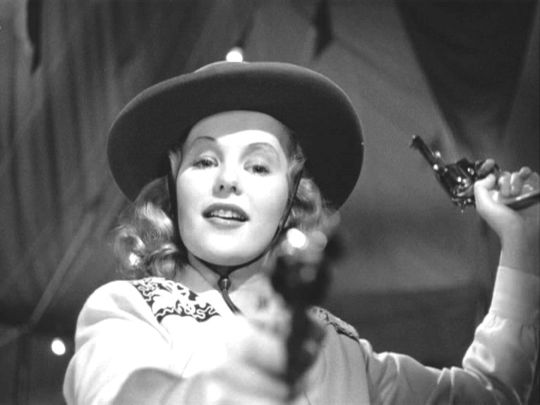
While Welles may have eulogized the genre with 1958's self-deprecating Touch of Evil, Lewis christened its rebirth a decade earlier with Gun Crazy, leading the genre's charge into a more chaotic and intensely introspective period. -- Christopher Justice [1]
Wroom, wroom, bang, bang.
These onomatopoetic words, often associated with the infantile, always seem to come to me when thinking of the right words for discussing 1950′s pulp film-noir. It was François Truffaut’s decision to include such words in the beginning of his review of a film by Samuel Fuller, and it is my decision to do the same in this essay about Gun Crazy (1950) by Joseph H. Lewis, another king of the B. The wonderfully straight-forward title of Lewis’ film -- which is, one might add, the more popular title in comparison to the alternative but equally outrageous Deadly Is the Female -- seems to outline its central themes: guns and craze. In this case, the latter does not only indicate psychic disintegration but also social and existential rapidity, that is, the hurry within man and his society, the being in the highest gear. Departing from the film-noirs which transcend the story by obfuscating narrative and plot, while resembling the film-noirs which transcend the story by simplifying narrative and plot, Gun Crazy never feels difficult or ambiguous due to the craze which reaches from the story to the level of form. It is evident to any viewer of the film that Gun Crazy can be grasped quite quickly as a three-act story, and this fact only emphasizes the depth of its wroom-wroom-bang-bang craze.
It begins with the juvenile yet ominous theft as a young boy (played by the young Russ Tamblyn, the future Twin Peaks star!) breaks the glass of a showcase of a gun store. His crime leads him to court which sends him to a boarding school. The gist of the first act concerns the boy’s return as a young man who has spent some time at the army after getting out of the boarding school. Accompanied by his two childhood friends, whose passion for guns was never as intense but neither was their disapproval of violence, the young man, named Bart, played by John Dall, visits a carnival where he encounters an alluring gunfighter the like he has never seen: mainly because she’s a she. The gunslinger from the opposite sex turns out to be a femme fatale who goes by the androgynous name Laurie, played by Peggy Cummins. The second act begins with the couple’s serene co-existence whose harmony is soon -- abruptly to the spectator, one might add -- interrupted due to Laurie’s ever-growing, demanding taste for the luxurious life, leading the duo eventually to the life of crime as bandits. Their happy life ends with the fatal heist of a meat packing factory whose failure puts a stop to their short-lived success. The third and final act depicts their constant run from the law which culminates in their death in the misty fields of desolation and poignant serenity.
Due to its obvious allusions to the strongly romanticized account of the criminal life of Bonnie and Clyde, Gun Crazy is easily associated with the great number of films taking inspiration from the legend, including Lang’s You Only Live Once (1937), Penn’s Bonnie and Clyde (1967), and Altman’s Thieves Like Us (1974). Yet it seems to me that Lewis’ film is best understood in connection not only to these “public enemy” stories but also to cinematic stories of mad love in general, that is to say, films such as Sjöström’s The Outlaw and His Wife (1918, Berg-Ejvind och hans hustru), Godard’s Pierrot le fou (1965), and Carax’s The Lovers on the Bridge (1991, Les amants du Pont-Neuf), which -- interestingly enough -- all revolve around lovers on the run.
These allusions capture something theme-wise, but the full understanding of the film’s context requires the appreciation of historical context. Gun Crazy is the first of the two films people usually have seen by Lewis, the second being The Big Combo (1955). Both are iconic film-noirs in the sense of developing and exploding archetypes. Both also include some of the most iconic shots associated with the genre: The Big Combo ends with the famous long shot of the female silhouette waiting for the man in fog, and Gun Crazy has the legendary sequence shot of the bank heist filmed entirely from the backseat of the couple’s getaway car. Both films also belong to the same period of the genre. If the classical era of film-noir ended with the final act of the Second World War after which the darker variation of the crime film turned into an even darker vision of a cynical world inhabited by disillusioned losers, representing the beginning of the new post-war era of the genre, then the final stage of film-noir is exemplified by the darkest variations of the dark crime film. It is the time when psychopaths, atom bombs, and hectically increasing hurry became emblematic of social and existential malaise. In this context, Gun Crazy finds its closest partners in crime in Aldrich’s Kiss Me Deadly (1955), Kazan’s Panic in the Streets (1950), Maté’s D.O.A. (1949), and Dmytryk’s The Sniper (1952).
Although this thematic and historical width of Lewis’ Gun Crazy opens the film up from its potential seclusion in eccentricity, it also challenges some genre conventions. According to film scholar Christopher Justice, Lewis’ film abandons narrative and visual conventions in using episodic structure, open spaces, and well-lit, daytime locations -- the antitheses for the iconic claustrophobic chambers of film-noir aesthetics [2]. While the story has the typical film-noir formula of a desperate, clueless man being driven into the lure of a femme fatale, the film does not reduce the woman into an embodiment of treacherousness (despite having the misogynistic alternative title), but rather uncovers the character as an archetype lost in authentic, even if utterly mad, love. Their love is mad because in the eternal symbiosis of Eros and Thanatos, their love engages with the lust for violence. Laurie might love Bart, but to her, love is always destructive and twisted. Nor does the film explain Bart’s desperate cluelessness by referring to any traditional situation of being cornered but rather to his existential strangeness and his desire to find a kindred spirit, a gun-loving soul lost in an unwelcoming world. In Spring Breakers (2012), they’d both be sucking guns.
From its title to its action, Gun Crazy is a film about guns which is why many contemporary spectators might find it hard to resist the temptation of locating Gun Crazy into the on-going debate about gun control which the rest of the world besides America is not having. Resisting the temptation or not, the way I see it, Gun Crazy is best understood when its gun theme is approached less concretely. In the era of sound film, guns seem to belong to the same category with cars and airplanes in that they are emblematic of a new age where transportation, violence, power, and social status are fundamentally changing. These technological inventions connote cultural pessimism, or the feeling that the new inventions have not improved our quality of life but rather have only accelerated our journey toward nothingness. With ironic thanks to modern medicine, we might be living longer, but we are also living faster and hence feeling like we are not living at all. We are “thrill crazy,” as the film’s poster describes itself. Guns carry a similar curse: "The film reminds us that guns are tools, instruments, and by-products of American democracy: they can build and destroy democratic states," as Justice sums up [3].
In addition to potential political meanings (bear in mind that one of the principal writers of Gun Crazy was the famous blacklisted scriptwriter Dalton Trumbo), critical literature on the gun theme of Gun Crazy is rife with psychoanalytic interpretations [4] which, to my mind, should not be considered exhaustive but rather the other side of the film-noir coin: for the dark genre is always best understood as the bastard child of wartime anguish, postwar disillusionment, existentialism, and psychoanalysis, all of which were cutting through the western world in the 40′s and the 50′s. As a result, the full understanding of any film-noir seems to require a holistic perspective which looks at the films from different viewpoints. To me, these viewpoints are best united when put together under the rubric of the films’ style and narrative.
In allusion to psychoanalysis, Gun Crazy begins with childhood and the lack of parental guidance. It begins with the young Bart’s obsession for guns which, despite eventually leading him to the life of crime, is not associated with violence. At court, Bart’s big sister a.k.a mother figure tells the story of Bart feeling deep remorse for once killing an innocent bird. Bart’s obsession for guns is different. Bart explains that shooting is the only thing he’s good at, and that upon shooting “it’s like I’m somebody.” Given the obvious phallic metaphors guns lend themselves to, it has become something of a standard interpretation to see Gun Crazy as an oedipal story. After all, Bart does not have a mother nor a father. Therefore, the entrance of Laurie into his life is phenomenal: Justice claims that “[p]sychosocially, she is Bart’s Oedipal mother and first love, but she is also the father figure he must compete with for approval” [5]. This seems most evident in the androgynous appearance of Laurie, who refuses to wear skirts to work and whose male outfit at the carnival is juxtaposed with her womanly figure emphasized by composition and lighting.
In true Lacanian expansion of Freudian ideas, the perennial oedipal complex which torments Bart’s existence manifests itself outside his relationship with Laurie in the society in general. It is clear to the spectator from very early on that the state has failed to help the boy without parents. The police officer in the beginning, the judge at the court, and the military forces all just pass him along. Without Laurie’s appearance, the capitalist carnival would have done the same. Unlike a Dickensian orphan, Bart does not end up in an abusive foster home or to an eccentric life of great expectations, however; rather he becomes a drifter who turns into a menace to society due to his rootlessness. To Justice, “Gun Crazy is fundamentally a visual and narrative rejection of the state, and Bart’s ‘fatherless state’ is a metaphor for America’s profound ineptness” [6]. Bart and Laurie are strangers to the mainstream; hence they abandon the state, they abandon bourgeois work, and they abandon traditional, “rational” love even at the expense of their life.
Both Laurie and Bart have a thirst for shooting. It’s what they’re good at. The gun is the phallos which Bart obsesses over due to the absence of his parents; it is the phallos which Laurie obsesses over due to the absence of male genitalia. They transfer their lack to guns which come to embody the object petit a, the unreachable object of desire which is now within arm’s reach. Laurie the woman is not as good at shooting as Bart the man -- though just by an inch, or by a match -- but she is a much more powerful figure since her obsession is deeply tied to violence. Bart can stop this destructive force in Laurie, the force that is now within him as well, only by shooting her which also leads to his own demise by the bullets of the police. He had to die. The woman, the force, the violent craze had become his raison d’être, the very condition of possibility for his existence.
While it’s all fine and dandy to throw around Freudian and Lacanian ideas when discussing films which really lend themselves to such discourses, I find it necessary to locate the social and psychological interpretations of the film in a wider context of narratology and stylistics which are captured by a phenomenological interpretation of the film [7]. As such, Gun Crazy is an existentialist tale of being which discloses crazy being through a crazy tone.
The crazy tone of Gun Crazy stems from Lewis’ narrative which is incredibly ardent, fast-paced, and economic. Take the first scene, for example. A boy and a showcase. The boy breaks the glass and takes a gun behind it. As he runs away, he slips in the rain and the stolen gun rolls to the feet of a police officer. Cluelessness and gun mania have been told to us about the protagonist. The next scene is the courtroom scene where we first hear witness accounts from other characters -- and see flashbacks focalized into their point of view (read: Bart’s perspective is conspicuous by its absence). Not until the very end of the scene do we hear what the boy himself has to say (”it’s like I’m somebody”) -- and with no focalized flashbacks. As the judge reads the sentence, Lewis’ camera slowly tracks toward the young Bart’s ear. By this subtle cinematic gesture, Lewis’ stark narrative emphasizes the strangeness of the boy, his state of being an outsider: he can hear, but he is not being heard. The external perspective prevails at the expense of the inner -- his strangeness cannot be understood. And it hurts because it is true. As the camera briefly lingers on Bart’s ear, the judge says from the off-screen space that the boy is to be put to a boarding school “until further notice.” What follows is a match cut from the ear to a telephone which Bart’s sister answers. The match cut, of course, cuts from Bart’s childhood to his adulthood. Nothing of his in-between adolescent years is told to us. Instead, narrative moves forward with a fervent speed.
In congruence with the rapidity of the tone, there are many single shots in the film which contain a lot of diegetic information that has been packed up economically: a journalist speaks about the robberies to a radio microphone and newspaper headlines fly toward the camera. Narrative economy is also characteristic for the film’s many montage sequences which cover the couple’s honey moon, their first series of heists, the media coverage of the heists, and an ever-growing police chase. Considering the film lasts less than 90 minutes -- that’s a lot of montage sequences. A certain mood of rapidity, hectic, and hurry characterizes these scenes. The mood takes over the whole of the film. A single shot where Lewis uses framing to connote meanings and feelings can be found in the scene where Laurie convinces Bart to do the one last heist of the meat packing company: as Laurie makes her demand, Bart lifts his head momentarily out of the screen into the off-screen space as if his cluelessness reached a peak, a new limit of despair, went beyond it, out of the screen space, and thus anticipated his voyage to non-existence accelerated by bullets. Before the journey, however, his head returns to the screen space to be convinced by Laurie’s embrace. Like the lingering shot of Bart’s ear at the trial, this shot also enhances the feeling of strangeness, being an outsider, being under the power of someone else by framing the character’s face off.
The ultimate moment of economic narrative is, of course, the film’s bravura shot, the robbery scene which is executed with one long sequence shot. At first glance, this Bazinian shot, which emphasizes duration, depth, and continuity, might seem contradictory to the aesthetics of hurry and craze I have been attributing to Gun Crazy. After all, Lewis’ decision to rely on such stylistic realism might remind one more of Italian neorealism and the quasi-documentary film-noir it inspired (The Naked City, 1948; Call Northside 777, 1948; The Set-Up, 1949) and, as such, the sequence shot might seem to stick out like a sore thumb -- given that there are no other shots like it in the entire film. On the other hand, this famous shot feels so modern that it could have been made convincingly in some nouvelle vague film. Godard’s Bande à part (1964) is the first which comes to mind since it makes homage to many film-noirs, Gun Crazy included. Taking this association into consideration, the shot does not seem to stick out so strongly. In Justice’s words, “Lewis’s contradictory, inconsistent style may be the most distinguishing characteristic of his directorial ethos, which reveals a radical departure from his contemporaries’ predictable technical and thematic approaches to genre, particularly film-noir” [8]. At best, the shot might be representative of Lewis’ aesthetic transgression anticipating the Godardian combination of Bazin and Eisenstein. In the end, maybe the enigma of the shot draws the spectator’s attention to time and movement, the fleeting Heraclitean flux of moments in the stream of which the modern man is about to burst into pieces, exploding in the intensity of a car crash and a gun bang.
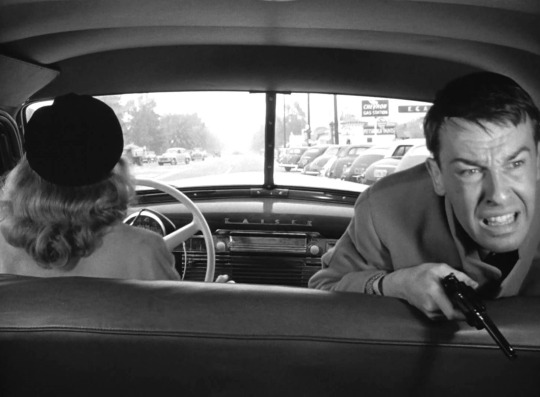
Rapid narrative, which provides diegetic information in a concise, economic fashion, is not necessarily a virtue on its own, but the way Lewis uses it in Gun Crazy certainly is. The crazy narrative reflects the mode of the characters’ being in the world. When Bart is telling Laurie about the fear he felt as he was shooting at the police car chasing them (Bart’s moment of guilt which the spectator associates with the earlier witness accounts of the dead bird and Bart’s subsequent reluctance to shoot a mountain lion because of that), he describes his feelings in a desperate tone: “It’s like everything was in high gear.” When Bart says these words, he is driving a car. He is driving the metaphor of the modern world, the vehicle partner of the gun, the wroom of the bang. It’s the only thing present in the surrounding environment that he can identify with. The car -- like the gun -- is an essential part of his being. The hectic and tormenting hurry which characterizes his existence to its core, but also feels strange and unhomely. He is in a way which he would not want to be, but he can’t help it. His being is in the highest gear toward nothingness. Recalling Godard’s Pierrot le fou -- and Godard was, of course, an admirer of Lewis --, Ferdinand, the protagonist of the film, looks into the mirror of his car and says that he sees nothing but “the face of a man who is driving towards a cliff at 100 km/h.” Ferdinand’s lover, Marianne, comforts him by saying that she sees “a woman who is in love with the man.” Similarly, Laurie tries to comfort Bart by saying that “at least we have each other” which is followed by Bart’s laconic reply: “but the rest is torture.”
It seems obvious that Bart is talking about the criminal life the couple is having (he would not have made the comment during their honey moon), but the fact of the matter is that this modern life of carelessness, enabled by their gun crazy ways, is the only life they could live. Thus Bart is speaking nothing but experienced truths about his mode of being in general, the being in the highest gear, which is exemplified by Lewis’ cinematic narrative.
If the rapidity, the cars, and the guns indicate the modern world, the breakdown of the couple’s getaway car in the middle of a forest road, while being chased by the police, and the following departure into the woods where they get lost indicate their final aberration from the modern world, the only life they knew, and the life they could not continue. Their aberration into nature denotes the approaching arrival of death, the burnout of their existential battery. As the day begins to dawn, they wake up on the misty fields where they are to die self-destructively -- in the rapid blink of an eye. There are no more sounds. There is no onomatopoeia for death.
Notes:
[1] Justice 2012, p. 228.
[2] Ibid. p. 237.
[3] Ibid. p. 231
[4] See Justice 2012; see also Lee 2012.
[5] Justice 2012, p. 229.
[6] Ibid. p. 233.
[7] What often lacks in political and psychoanalytic interpretations of films is an attentive discussion on style and narrative. Though this is hardly the case in every situation, I find it better to enrich those interpretations with a wider context of a phenomenological approach which appreciates the relations between the film’s topic, theme, narrative, and style.
[8] Justice 2012, 225.
References:
Justice, Christopher. 2012. "Rejecting Everything: Gun Crazy and the Radical Noir of Joseph H. Lewis". In Gary D. Rhodes (ed.) The Films of Joseph H. Lewis. Detroit: Wayne State University Press, p. 223-241.
Lee, Michael. 2012. “Music, Masculinity, and Masochism in Gun Crazy”. In Gary D. Rhodes (ed.) The Films of Joseph H. Lewis. Detroit: Wayne State University Press, p. 242-254.
5 notes
·
View notes